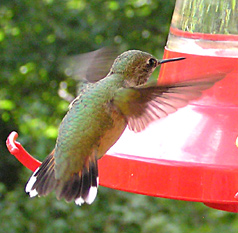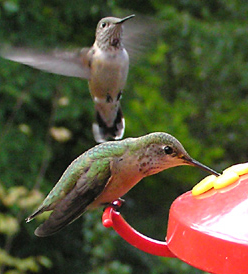Utah County Birders Newsletter
|
||||||||||||||||||||||||||||||||||||||||||||
|
Bird |
Mnemonic |
|
Belted Kingfisher |
Flight call sounds like a baby’s rattle |
|
California Quail |
Chi-CA-go! |
|
Olive-sided Flycatcher |
I say there. (the middle note highest, last one sliding) |
|
Yellow Warbler |
Sweet, sweet, sweeter than sweet |
|
Red-breasted Nuthatch |
Yank Yank (sounds as if it came from a toy horn) |
|
Black-capped Chickadee |
Chick-a-dee-dee-dee (says its name) |
|
Common Yellowthroat |
witchity-witchity-witchity |
The next time you say “How did you know that?” after a birder identifies a bird
by its voice, it might be a secret trick known amongst good birders. The secret
trick is the 4 Ss. The Ss are: site, season, situation, and sound. It’s
knowing which birds are found in specific sites or habitats (e.g., Juniper
Titmouse and Pinyon Jays are found in pinyon-juniper woodlands), time of year
(e.g., Yellow-billed Cuckoos won’t be a potential bird in Utah Valley until
summer), and by their situation (e.g., Acorn Woodpeckers are known for their
elaborate caching methods).
Every birder should know that Empidonax flycatchers are usually identified by “ear only.” Each species within this group is separable from each other only by voice. On a field trip I noticed that Eric Huish, an excellent Utah County birder, has on his checklist a space for Empids to record this tough-to-identify group of birds which are best recognized by sound.
While some Eastern birders in areas with thick forests claim to identify over 80% of their birds on a trip by ear without seeing the bird, few of us are in that category. The world’s best ornithologist, Ted Parker was said to be able to identify over 2,000 bird species by ear. (note: Ted Parker died in 1993 when his light plane crashed into a mountainside while making a treetop survey of an Ecuadorian cloud forest)
Some birders, especially as you get older, may have difficulty hearing high-pitched bird songs. Hearing aids adapted for use outdoors work well. The larger sporting stores have them (e.g., Sportsman’s Warehouse, Cabela’s). One technique which increases the hearing by 25% in most people, and which I have seen only one birder, Eric Huish, use is to place cupped hands behind both ears. Try it, you will be surprised at the increased volume.
Birding by ear takes practice. The best way to learn bird
songs is to see and hear the bird in the field. To learn faster, listen to
birdsong tapes, CDs, or software programs—even the internet has bird song
sites. Its a great winter time activity when few song birds are around, and it
gets you ready for spring. Remember to concentrate on the birds you are likely
to see and not a rarity. Another time to listen is while driving; however, I
get bored after about 10 minutes. You can’t go wrong by purchasing the Stokes
Field Guide to Bird Songs (Western Region). Our own Dr. Kevin Colver of Elk
Ridge, Utah (south end of Utah County) did the western bird recordings for the
Stokes CDs (also Dennis Shirley accompanied and helped Dr. Colver for many of
the recordings).
Identifying Female Hummingbirds
by Eric Huish
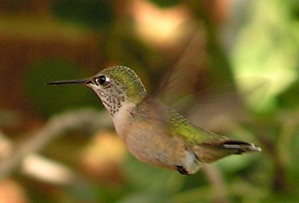 |
|
Calliope Hummingbird photo by Eric Huish |
In birding there are many ID challenges that require an eye for slight differences between similar species. The ideal way to learn the finer details of identification with such species is to find time to study live birds of similar species side by side at close range. Such conditions are sometimes hard to come by but about a month from now many of us will have such ideal conditions right in our own backyards. In the late summer and fall season my hummingbird feeders swarm with female and immature hummers and if I stand very still I can watch the birds from just a couple of feet away.
Two years ago I saw a plain hummingbird at my feeders that looked extra small to me. Up to that point I had been passing most female hummingbirds by without identifying them to species. "Just wait for a male to come along." Since a Calliope would be a Lifer I decided to see if I could put a positive identity on this small hummingbird. So I pulled out my field guides to learn what a female Calliope would look like and found it harder to identify than anticipated.
I spent a few evenings that year and the next studying the hummingbirds at
my feeders and now, if I get a good look, I feel I can identify many (not
all) of the female hummingbirds I see here in Utah. If you would like to try
this, here are some tips:
1) The hummingbirds come to feeders in
especially large numbers (and are more likely to come up to the feeder
with you standing there) in the evening about a half hour before they have
to retire for the night so this is the best time to watch.
2) Read up on identifying hummingbirds before you go out so you know what
to look for. You can find ID information on
hummingbird web-sites, in field guides and hummingbird books. I
found Advanced Birding by Kenn Kaufman especially helpful.
3) Spend 15
minutes watching the birds at least a few nights during the fall season.
Your ability to recognize the differences will increase with the practice.
I became familiar with only the four species that come regularly to my feeders. For the most part, these four are the only species we get in central Utah. They are; Black-chinned, Broad-tailed, Rufous and Calliope. Below are some differences I noticed between each. Most of these field marks I noticed after being told what to look for in books. I am not an expert, so use your field guides and trust them over what you read in my descriptions. The following descriptions are for female/juvenile birds only.
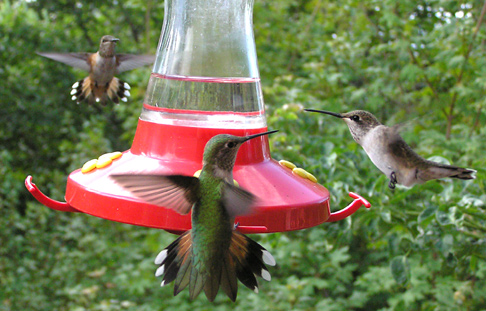 |
|||||
| Photo 1. Broad-tailed (center), Black-chinned (right) and Rufous (left) Hummingbirds. During fall migration you are often able to compare different species side by side. Note the Broad-tailed's broader tail with much rufous at the base but less extensive rufous than the Rufous Hummingbird in the background. | |||||
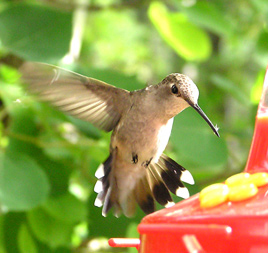 |
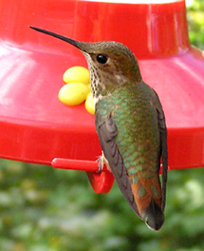 |
||||
| Photo 2. Black-chinned Hummingbird. Note the grayish color and no rufous at the base of the tail feathers. | Photo 3. Rufous Hummingbird. Many female Rufous have the rusty coloring up onto the uppertail coverts. | ||||
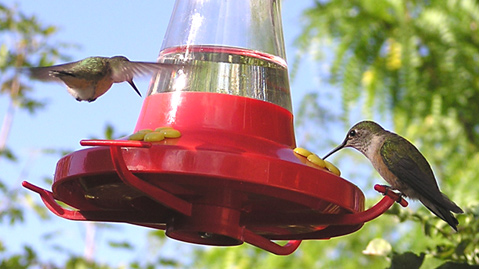 |
|||||
| Photo 4. Calliope (Left) and Broad-tailed (right) Hummingbirds. Note the size difference and the long tail on the Broad-tailed Hummingbird. | |||||
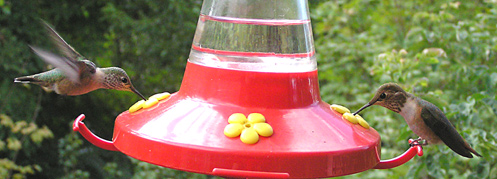 |
|||||
| Photo 5. Calliope (left) and Rufous (right) Hummingbirds. When these two species are side by side you can see the slight size difference but a lone young Rufous Hummingbird can look very small. Note the short tail on the Calliope. | |||||
|
|||||
Black-Chinned Hummingbird - The females are fairly plain and grayish (photo 1 & 2) compared to Broad-tailed, Rufous and Calliope which have rufous or buffy coloring in the tail and on the flanks. (I have seen some juvenile Black-chinneds with buff edges on their back feathers). To me the Black-chinneds often look knob-headed (except on cold days when they puff up their feathers). They often have a dark grayish smudge behind their eyes and their bill looks a little decurved. The two Utah hummers most easily confused with black-chinned are Anna's and Costa's which I am not very familiar with.
Broad-tailed Hummingbird - Broad-taileds have a broad tail (photo 1)
which with practice should help you in identifying this species.
Broad-taileds are larger than Rufous and Calliope (photo4), they have less rufous
coloring at the base of their tail than Rufous Hummingbids
(photo 1) and more than Calliope (photo 6).
Rufous Hummingbird - Adult females are easy to identify because
they have so much rufous feathering (photo 3) and have an orange-red
central spot on the throat (photo 7). Juvenile females are plainer. Rufous
Hummingbirds are larger than Calliope (photo 5) and smaller than Broad-tailed but if you see
them alone it is hard to judge size. The rufous on the flanks is
usually darker than in Calliope and Broad-tailed and it washes out to
white in the center of the chest. Juvenile female Rufous Hummingbirds are
very similar to Calliope Hummingbirds and I have seen birds at my feeder
that (even from a few feet away) I couldn't identify.
Calliope Hummingbird - Calliopes are the smallest and have shorter
bills and tails. They have a little rufous coloring at the base of
the tail (photo 6) which is often hard to see. The buffy wash on the chest is paler and more uniform than on Rufous
hummingbirds. The oft-read-about field mark of the wing tips
reaching slightly beyond the tail tip on a perched Calliope (photo 7) is a helpful
characteristic, but occasionally the tail can appear to reach beyond the
wing tips and young Rufous Hummingbirds wingtips can appear to reach the
tail tip. The Calliopes' tail looks short even if the wingtips
aren't there to measure it by (See photo at top of article). The spatulate or 'peanut
shaped' central tail feathers of the Calliope (photo 6) are, I think, the most
diagnostic feature of that species although very hard to see. The tail feathers are a little
narrower in the center like a peanut. If you hold very still and keep your
head right next to the feeder the birds will sometimes land close enough
for you to see this characteristic. After first seeing this
characteristic I was finally confident enough in my identification of a
Calliope to concentrate on the other, more subtle, differences between
that bird and the others.
One other interesting note: When I was standing very still next to the feeders and couldn't move my head I could often tell when a Calliope or Broad-tailed was about to come into my field of view because their wings 'hummed' at a higher (Calliope) and lower (Broad-tailed) pitch than the Black-chinneds and Rufous.
Field Trip Report
Tintic Mountains - 9 July 2005
by Flora M. Duncan
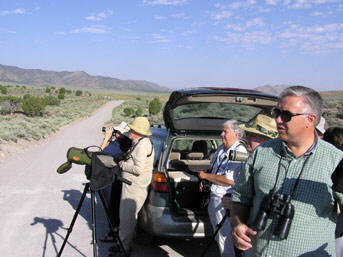 |
|
Utah County Birders near Chimney Rock
- 9 July 2005 |
Nine early morning birders gathered with expectation of seeing Bush Tits,
Pinyon Jays, Burrowing Owls.
We traveled first to Mile Marker 1 north of Elberta, then via Chimney Rock Pass
to Eureka and Dividend.
Of the twenty-nine species, several birders had lifers for Utah County or lifers
for Utah. Some of the first sightings for some are: Sage Thrasher, Gray Vireo,
Black-throated Gray Warbler, Gray Flycatcher. Of special interest were four
Canyon Wrens close to the road. Eric’s sharp ears detected several birds heard
only.
Someone observed that the Horned Larks and Meadow Larks looked strange--probably
because they were fledglings.
Bonus sightings included: two Pronghorns, Mule deer and a Jack Rabbit.
------------------------------------------------------
Field Trip Report
Payson Canyon - 13 July 2005
by Eric Huish
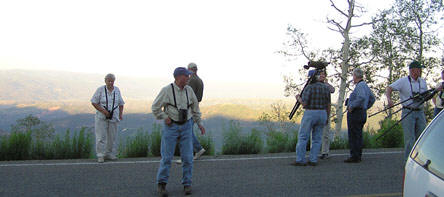 |
|
Watching the Purple Martins in Payson
Canyon - 13 July 2005 |
We had a very large turnout for this evening field trip up Payson Canyon led
by Dennis Shirley. The temperature down in the valley had been incredibly hot
for days, so it was nice to greet refreshingly cool temperatures at our first
stop in the canyon.
The views lit by the evening light were very scenic and we saw many birds.
Highlights included: Singing Fox Sparrows at our first stop, the Purple Martins
nesting alongside the road and the Pine Grosbeak Aaron Smith found at the Nebo
Bench trailhead.
Backyard Bird of the
Month
July 2005
KC Childs - Orem
Lesser Goldfinch - there’s not much buzzing around.
Steve Carr - Holladay
Black-headed Grosbeak - Nesting pair.
Eric Huish - Pleasant Grove
Mallard - Hen with six newly hatched ducklings.
Milt Moody - Provo
Black-headed Grosbeak family - 3 kids, two parents
Cheryl Peterson - Provo
Black-capped Chickadees and Hummingbirds have been so fun to
watch.
Bonnie Williams - Mapleton
Lesser Goldfinch - with almost all white tail.
We would like you to share your favorite backyard bird each
month. Please send your favorite bird at the end of the month to
newsletter@utahbirds.org or call 360-8777. If you would like a reminder at
the end of the month e-mail the above address.
